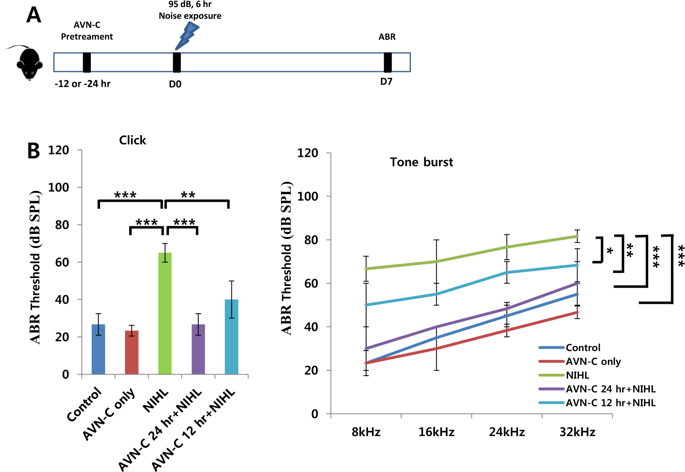Cell Death Discovery ( IF 6.1 ) Pub Date : 2019-07-08 , DOI: 10.1038/s41420-019-0195-1 Alphonse Umugire , Sungsu Lee , Dami Kim , Munyoung Choi , Hyung-Seok Kim , Hyong-Ho Cho

|
Noise exposure or ototoxic drugs instigate various types of damage to the cochlea, resulting in hearing loss (HL). While the incidence of HL is growing continuously, there are, so far, no adequate drugs to prevent or treat HL. Avenanthramide (AVN), a natural product extracted from oats, has been reported to possess anti-oxidant/inflammatory properties, and protect several types of cells. In this study, we investigated whether AVN-C can protect auditory hair cells, and preserve hearing from noise trauma and ototoxic drugs. Wild-type C57BL/6 mice were used to generate several HL models. Serum and perilymphatic fluid samples were analyzed using mass spectrophotometry to detect AVN-C. AVN-C crossed the blood-labyrinth barrier, and was detected in the perilymph after systemic injection. Pretreatment by AVN-C 24 h before exposure to temporary threshold shift noise contributed to the preserving hearing. Moreover, in the case of permanent threshold shift, AVN-C provided significant protection from noise. AVN-C also strongly protected against deterioration in hearing due to kanamycin and furosemide (K + F). According to the results of our scanning electron microscopy analysis, many outer hair cells (OHCs) were destroyed by noise trauma, while AVN-C prevented these losses. OHC loss due to K + F was even more severe, even affecting the apex. Strikingly, AVN-C treatment maintained OHCs at a level comparable to normal cochlea. AVN-C reduced the dichlorofluorescin (DCF)-positive population in gentamicin-treated HEI-OC1 in vitro. The expressions of TNF-a, BAK, IL-1b, and Bcl-2 were attenuated by AVN-C, revealing its antioxidant effects. The results of this study show that AVN-C crosses the blood-labyrinth barrier and provide a significant protection against noise- and drug-induced ototoxicity. Hence, AVN-C is a good candidate for future therapy aimed at protecting against sensorineural HL.
中文翻译:

Avenanthramide-C可防止噪音和药物引起的听力损失,同时保护听觉毛细胞免受氧化应激
噪音暴露或耳毒性药物会刺激耳蜗的各种类型的损伤,从而导致听力损失(HL)。尽管HL的发病率持续增长,但到目前为止,尚无足够的药物来预防或治疗HL。据报道,从燕麦中提取的天然产物Avenanthramide(AVN)具有抗氧化/抗炎特性,并能保护多种类型的细胞。在这项研究中,我们调查了AVN-C是否可以保护听觉毛细胞,并保持听觉不受噪声创伤和耳毒性药物的影响。使用野生型C57BL / 6小鼠来生成几种HL模型。使用质谱法分析血清和淋巴液样本,以检测AVN-C。AVN-C越过了血液的迷宫屏障,在全身注射后在淋巴中被检测到。在暴露于暂时性阈值移位噪声之前24小时通过AVN-C进行预处理有助于保持听力。此外,在永久阈值偏移的情况下,AVN-C提供了显着的噪声防护。AVN-C还可以有效防止卡那霉素和速尿(K + F)引起的听力恶化。根据我们的扫描电子显微镜分析结果,许多外毛细胞(OHC)被噪声损伤破坏,而AVN-C阻止了这些损失。由于K + F而引起的OHC损失甚至更为严重,甚至影响到根尖。令人惊讶的是,AVN-C治疗可将OHC维持在与正常耳蜗相当的水平。在体外,AVN-C减少了庆大霉素处理的HEI-OC1中的二氯荧光素(DCF)阳性人群。AVN-C减弱了TNF-a,BAK,IL-1b和Bcl-2的表达,显示出其抗氧化作用。这项研究的结果表明,AVN-C可以越过血液的迷宫屏障,并且对噪声和药物引起的耳毒性具有显着的保护作用。因此,AVN-C是未来旨在预防感音神经性HL疗法的良好候选者。











































 京公网安备 11010802027423号
京公网安备 11010802027423号